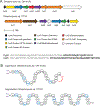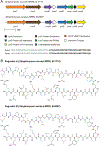Bioinformatic and Reactivity-Based Discovery of Linaridins
- PMID: 33170617
- PMCID: PMC7680433
- DOI: 10.1021/acschembio.0c00620
Bioinformatic and Reactivity-Based Discovery of Linaridins
Abstract
Linaridins are members of the ribosomally synthesized and post-translationally modified peptide (RiPP) family of natural products. Five linaridins have been reported, which are defined by the presence of dehydrobutyrine, a dehydrated, alkene-containing amino acid derived from threonine. This work describes the development of a linaridin-specific scoring module for Rapid ORF Description and Evaluation Online (RODEO), a genome-mining tool tailored toward RiPP discovery. Upon mining publicly accessible genomes available in the NCBI database, RODEO identified 561 (382 nonredundant) linaridin biosynthetic gene clusters. Linaridin BGCs with unique gene architectures and precursor sequences markedly different from previous predictions were uncovered during these efforts. To aid in data set validation, two new linaridins, pegvadin A and B, were detected through reactivity-based screening and isolated from Streptomyces noursei and Streptomyces auratus, respectively. Reactivity-based screening involves the use of a probe that chemoselectively modifies an organic functional group present in the natural product. The dehydrated amino acids present in linaridins as α/β-unsaturated carbonyls were appropriate electrophiles for nucleophilic 1,4-addition using a thiol-functionalized probe. The data presented within significantly expand the number of predicted linaridin biosynthetic gene clusters and serve as a roadmap for future work in the area. The combination of bioinformatics and reactivity-based screening is a powerful approach to accelerate natural product discovery.
Conflict of interest statement
Notes
The authors declare no competing financial interest.
Figures




References
-
- Hadjithomas M; Chen I-MA; Chu K; Huang J; Ratner A; Palaniappan K; Andersen E; Markowitz V; Kyrpides NC; Ivanova NN New Features for Bacterial Secondary Metabolism Analysis and Targeted Biosynthetic Gene Cluster Discovery in Thousands of Microbial Genomes. Nucleic Acids Res. 2017, 45 (D1), D560–D565. - PMC - PubMed
-
- Ziemert N; Alanjary M; Weber T The Evolution of Genome Mining in Microbes – a Review. Nat. Prod. Rep 2016, 33 (8), 988–1005. - PubMed
Publication types
MeSH terms
Substances
Supplementary concepts
Grants and funding
LinkOut - more resources
Full Text Sources
Molecular Biology Databases

